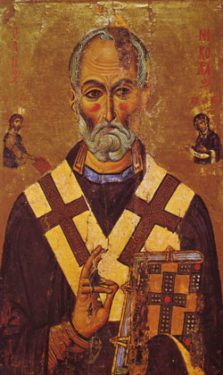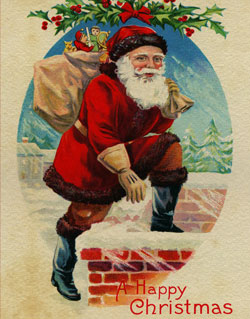My dear brothers and sisters in the Lord,

As we begin the Season of Advent, one of the first feasts we celebrate during this time is the Feast of St. Nicholas on December 6. Since St. Nicholas is my patron saint, I thought I would take the time to describe the journey of St. Nicholas, Bishop of Myra in Turkey, to his more popular transformation into Santa Claus.
He was born in Patara, Asia Minor, which is Demre in modern day Turkey; probably in the year 255 A.D. Nicholas was born to a wealthy family who most probably was already Christian in a time when Christianity was not legal in the Roman Empire. One of the most famous stories about Nicholas, before he was a bishop, is the rescue of three young girls whose father, in desperation of not having any dowry for them, was ready to sell his daughters into prostitution. On three successive nights, St. Nicholas threw over the wall of their house three bags of gold sufficient to provide a dowry for each of the man’s daughters. In the legend of Santa Claus, we learn that St. Nicholas threw the bags of gold – and now presents – down the chimney. It would seem that along with many other accretions of time, however, the miracles of St. Nicholas have become mixed with his life of charity.
In the year 300, the Bishop of Myra died and Nicholas was elected by the people, as was the custom of that time, to be their bishop. In 303, persecution by Emperor Diocletian broke out and was the last and most furious one against Christians all over the empire. Nicholas was imprisoned and suffered for the faith. Fortunately, the persecution ended and by 313 Constantine, who had received a vision that he would conquer in the Sign of the Cross, legalized Christianity throughout the empire.
In a very short time in 325, the bishops of the Church gathered in one of the first councils ever to be called, the Council of Nicaea. The purpose of this council was to combat the heresy of Arianism, which held that Christ was not divine if He had been begotten by the Father. Also, that Mary could not be called the Mother of God, or Theotokos, if He was not divine. The annals of the Council of Nicaea contained the names of all the bishops who attended, as each had to sign their name; among those listed was Nicholas of Myra, a staunch defender of the faith. One legend that cannot be verified is that Nicholas lost his temper during the Council and went up to Arius and slapped him. Nicholas was punished and removed by the Council, however, he was shortly reinstated. He seemed to have a temper that served to give him zeal, but also one which caused him problems.

The life of St. Nicholas for more than 70 years was one that edified not only the people of his diocese, but also the bishops of the world. With all that he did during his time as a bishop, however, he seems to be most remembered for the devotion that this saint has received after his death and the miracles that have been accomplished through his intercession. In 1087, Myra was under the domination of the Mohammedans and certain merchants from Bari were successful in taking the relics of Nicholas from the cathedral in Myra and to bring them to Bari where in fact today the Basilica of St. Nicholas is found. I, myself, was able to visit there in 1994 and witnessed the great devotion to which St. Nicholas is held. This tomb has become a place of pilgrimage not only for the Western Church but also for the churches of the East. Perhaps the greatest popularity of St. Nicholas today is with the Orthodox Church in Russia. Only three years ago, our Holy Father, Pope Francis, allowed the relics of St. Nicholas to be taken to Moscow to be venerated by the faithful. Over two million Russians visited the relics of St. Nicholas in the cathedral in Moscow attesting to his popularity in both the East and the West. At his tomb today, there is a column beneath the place of his relics, which continually oozes oil. It is called the Manna of St. Nicholas. The source of this oil like substance is unknown. But it has continued to be a source of devotion to all those who visit his tomb.
St. Nicholas has become the patron of many different people; including sailors and children. This brings us to the transformation of Bishop Nicholas to the present day Santa Claus. During the Reformation, the knowledge of St. Nicholas survived since he was the friend of children. In the Dutch language, Santa Claus is the nickname for Sinter Klaas, a shortened form of Sint Nicolaas, Dutch for Saint Nicholas. And so the custom of giving gifts to children on the Feast of St. Nicholas was preserved. The red costume of Santa Claus and his hat, a collapsed mitre, attests to the fact that he truly is a caricature of St. Nicholas.
The name Nicholas means the “victory of the people,” two Greek words that signify strength and accomplishment. As we put out into the deep of this Advent Season, perhaps we can remember the characteristics of this saint whose feast we celebrate at the beginning of Advent. Nicholas was a man of charity, and also a man who suffered for his faith and was able to uphold the clear doctrine of what we believe. Recently, in speaking with a wonderful member of our diocese, he mentioned to me something his daughter told him regarding the present situation of the Church. She said to her father, “The Church may be in crisis, but my faith is not.” Perhaps during this Advent Season, we can remember that our faith is not dependent on any individual member of the Church be they priest, bishop or even pope. Rather, our faith is dependent on Jesus Christ, its founder. Pray with me to St. Nicholas during this time of Advent that the peoples’ victory of faith will prevail.

Thank you Bishop Nicholas for the very informative history information, but more so for the final statement/s all related to our faith and our Church Founder, Jesus. The faith is strong because of His role as Son of the Father.